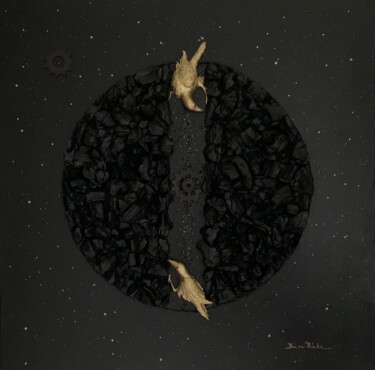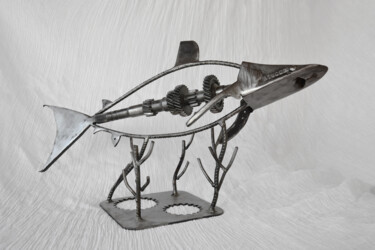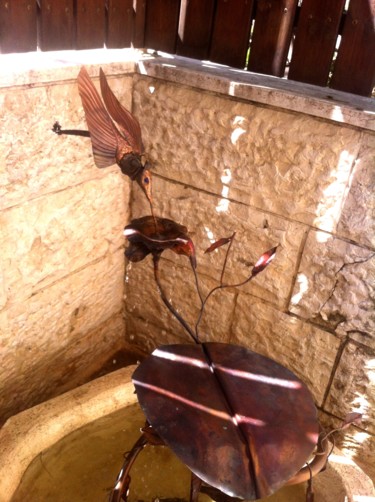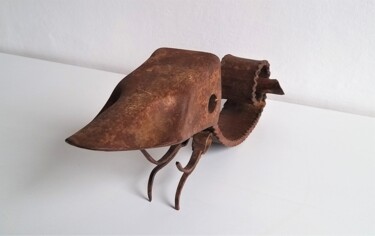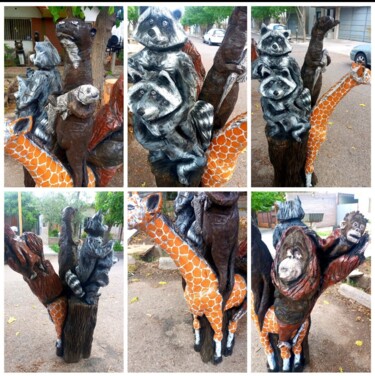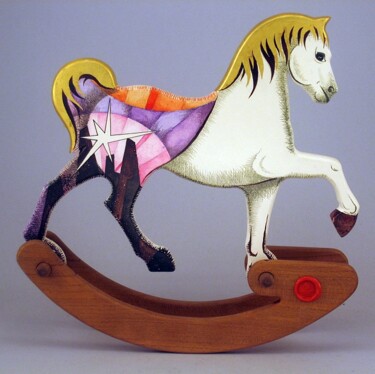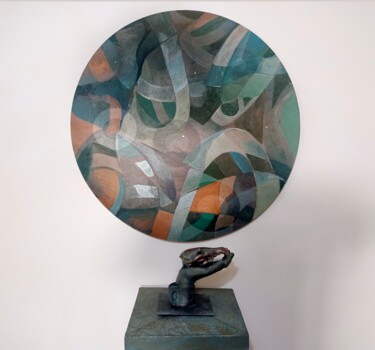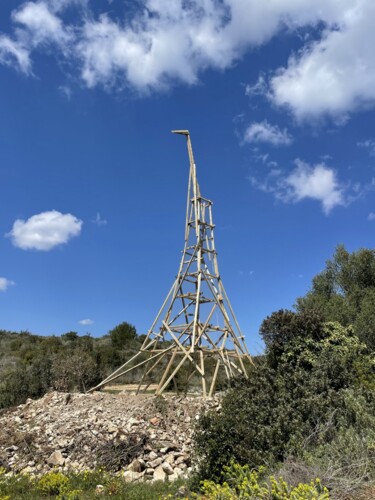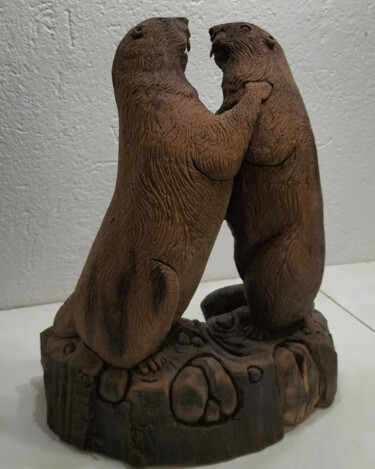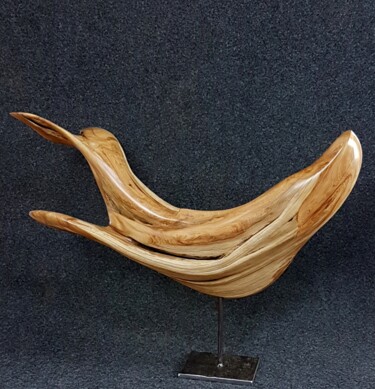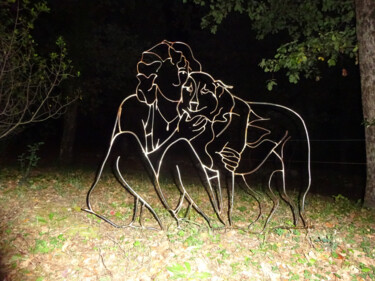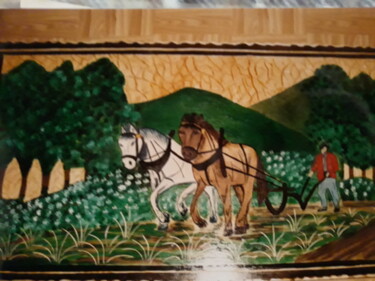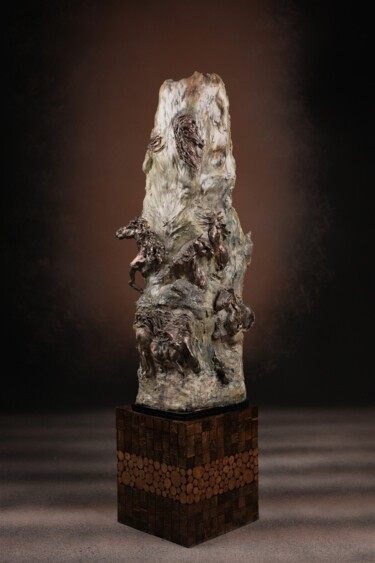
19 Esculturas contemporâneas originais à venda:
Como definir estilo Land Art ?
A Land Art, também conhecida como Earth Art, é criada diretamente na paisagem, esculpindo-a ou construindo ali estruturas de materiais naturais. Land art foi um protesto contra a "comercialização implacável" da arte na América ao longo dos anos 1960 e 1970. No entanto, a documentação fotográfica era frequentemente exibida em espaços de galeria convencionais. Durante esse período, os defensores da land art rejeitaram o museu ou a galeria como cenário para a atividade artística e criaram projetos paisagísticos monumentais que estavam fora do escopo da escultura transportável tradicional e do mercado de arte comercial. A arte minimalista e conceitual, bem como tendências contemporâneas como De Stijl, cubismo, minimalismo e as obras de Constantin Brâncuși e Joseph Beuys serviram de inspiração para a Land art.
As principais preocupações do movimento artístico eram sua oposição à comercialização das artes e seu entusiasmo pelo movimento ecológico emergente. A prevalência do sentimento antiurbano e sua paixão compensatória pela vida no campo coincidiram com o movimento artístico. As aspirações espirituais para que a Terra servisse como lar da humanidade estavam entre esses impulsos.
Um método baseado em processo de criação de arte, onde o artista faria excursões no ambiente circundante para coletar objetos ou realizar intervenções específicas do local, evoluiu rapidamente do que havia começado como uma tendência na escultura para incorporar materiais naturais como terra, pedras , e plantas. Enquanto alguns artistas criaram intervenções temporárias e limitadas na paisagem, outros usaram equipamentos mecânicos de terraplenagem para criar suas obras de terraplenagem. Para apresentação em galerias, os artistas frequentemente usavam fotografias, filmes e mapas para documentar suas obras de terraplenagem. Além disso, combinando elementos orgânicos do ambiente em esculturas e instalações, os artistas da terra criaram arte nas galerias.
O primeiro museu americano a apresentar uma exposição de arte da Terra, simplesmente intitulada Earth Art, foi o Herbert F. Johnson Museum of Art na Cornell University em fevereiro de 1969. As obras de arte estavam em exibição no museu, bem como em todo o campus de Ithaca da Cornell University. , proporcionando um local para peças que mais tarde continuariam a desafiar o status da arte como mercadoria, particularmente aquelas instalações que borravam as linhas entre o contexto de um objeto e seus arredores.
Land Art Escultura
Através dos materiais que empregaram e dos locais de suas obras, os Land Artists exploraram os limites da arte, frequentemente alterando ativamente a paisagem para criar suas esculturas e instalações. Essas obras de arte eram freqüentemente esculpidas diretamente na terra ou transformadas em arte de terraplenagem pelo artista utilizando os recursos naturais disponíveis. O uso desses elementos homenageou a singularidade do local e incluiu terra, plantas, rochas, cascalho, pedras, galhos e água, que eram frequentemente encontrados no local.
A arte da Terra que foi produzida introduziu a ideia de especificidade de localização no mundo da arte. Devido ao facto de estas obras de arte nem sempre estarem acessíveis aos visitantes e de os artistas serem por vezes as únicas pessoas conscientes da sua existência, estas esculturas colocam os artistas no centro das suas criações. Como resultado, os artistas frequentemente registram seu trabalho por meio de fotografias, que posteriormente usam para exibir no lugar de suas obras reais em galerias de arte.
Como o movimento Land Art se opôs à brutal comercialização da arte ao longo dos anos 1960, essa mudança de cenário desafiou a noção de que a arte existe apenas como algo a ser observado. Esses trabalhos investigaram um retorno à natureza, que provocou o crescimento do movimento ambiental que reconheceu a Terra como o verdadeiro lar da humanidade. Como resultado, os artistas da terra começaram a criar arte da terra que glorificava esse ideal e mostrava uma rejeição completa da vida metropolitana.
Como os locais tradicionais de atividade artística, museus e galerias, foram abandonados, os artistas tiveram a oportunidade de criar esculturas monumentais que estavam fora do escopo das obras de arte transportáveis tradicionais. Os artistas da terra foram compelidos a confiar no sistema que odiavam para apoiar suas ideias caras, a fim de produzir esculturas e instalações fora das galerias convencionais e locais de museus. Enormes instalações paisagísticas frequentemente exigiam a compra de terrenos e o uso de ferramentas de terraplenagem; patronos ricos e fundações privadas freqüentemente forneciam fundos para esses projetos extravagantes.
Escultores de Land Art
Robert Smithson (1938-1973)
O artista americano Robert Smithson foi provavelmente um dos pioneiros mais significativos desse movimento. Como resposta ao afastamento do Modernismo das questões sociais, seu ensaio de 1968 "A Sedimentação da Mente: Projetos da Terra" ofereceu uma estrutura crítica para o movimento. Para criar composições escultóricas tridimensionais, ele começou a combinar vários materiais. Isso deu origem a uma série de trabalhos "non-sites", nos quais esculturas feitas de terra e rochas trazidas de expedições foram colocadas dentro de galerias. Essas esculturas freqüentemente incluíam mapas, lixeiras, espelhos, vidro e neon. As obras de Smithson Spiral Jetty (1970), Broken Circle/Spiral Hill (1971) e Amarillo Ramp (1973) são suas criações mais famosas (1973). Ao remover completamente a arte do contexto da galeria e integrá-la ao terreno natural, ele alterou para sempre os conceitos preconcebidos de forma escultural na arte contemporânea.
Walter De Maria (1935-2013)
Em suas esculturas, instalações e landworks, Walter de Maria utilizou formas geométricas para produzir uma sucessão de repetições que exploravam a ligação entre o relativo e o absoluto. Lighting Field (1977), sua obra de arte terrestre mais conhecida, é uma grade de uma milha por um quilômetro quadrado que foi colocada em uma parte remota do deserto do Novo México. Quatrocentos postes de aço inoxidável polido com mais de seis metros de altura e pontas pontiagudas que definem um plano horizontal - o ponto de atração dos raios - compõem a grade. O visitante pode entrar na grade fisicamente ou observá-la à distância, em uma série de poderosas ilusões de ótica que variam com o tempo e o espaço, arte, paisagem e natureza colidem.
Dennis Oppenheim (1938-2011)
As primeiras intervenções de Oppenheim no mundo natural, em contraste com as de muitos de seus contemporâneos, assumiram a forma de remoção, voltando ao princípio escultórico tradicional de esculpir, nas palavras do próprio artista, "tirar em vez de adicionar". Limites geopolíticos, fusos horários e degradação natural são apenas alguns exemplos dos sistemas sociais e naturais referenciados e destacados em Annual Rings (1968), um trabalho específico do local. A reprodução do mapa serve para demonstrar como o mapeamento desempenha um papel na criação de fronteiras não naturais e frequentemente violentas entre os estados e o rio, uma fronteira natural, serve como uma ferramenta para essas fronteiras internacionais.
Oppenheim questionou "os valores relativos dos sistemas de ordenação pelos quais vivemos", justapondo elementos naturais com ideias artificiais, como nacionalidade e fusos horários. Ao mesmo tempo, artistas da terra como Robert Smithson e Walter de Maria também estavam produzindo trabalhos de terra específicos onde ambientes naturais eram colocados em conflito com intervenções artificiais.
Nancy Holt (1938 - 2014)
As esculturas públicas, a arte de instalação e a Land Art que Holt criou ao longo de sua carreira são as mais conhecidas, junto com alguns de seus vídeos e fotografias experimentais. Para dar continuidade ao espírito inventivo e curioso das obras dela e de seu marido (Robert Smithson), Holt fundou a Fundação Holt/Smithson em 2017. Por meio de sua prática escultórica, eles criaram novas abordagens para explorar nossa relação com o mundo.
Richard Long (nascido em 1945)
Um conhecido escultor britânico envolvido com o movimento Land Art foi Richard Long. No final da década de 1960, o artista inicia sua interação direta com a natureza, utilizando como meio o passeio, motivado pelo desejo de utilizar a paisagem de novas formas. Long tentou subverter a linguagem e as aspirações da arte e trazê-la para um nível mais básico, íntimo e fundamental por meio de uma sequência de gestos repetitivos ou caminhadas solitárias prolongadas. Seu objetivo era exemplificar em si mesmo as possibilidades de uma conversa não adulterada entre o homem e o meio ambiente. Tempo, espaço e distância são os temas deste inovador projeto conceitual de land art, e eles são expandidos em grande escala.
Andy Goldsworthy (nascido em 1956)
Andy Goldsworthy é um conhecido escultor e fotógrafo de land art que trabalha na e com a natureza. Sua produção pode ser classificada em projetos permanentes e temporários. Os últimos são projetados para desaparecer no final do ciclo de vida e são construídos a partir de componentes orgânicos e transitórios. Ele cria uma série de desenhos repetitivos, incluindo espirais, círculos e linhas sinuosas, a partir de galhos, folhas, pedras e gelo. A efemeridade no centro dessas iniciativas é um reflexo de uma ecologia frágil e de um ambiente natural em constante mudança.
Compra de obras de arte sobre o tema " Animal "
Os animais são o tema favorito dos escultores. Animais de estimação, animais de fazenda, animais selvagens ou animais exóticos ... Escultores em busca de inspiração têm muitas opções para suas estátuas! Todos os animais têm características físicas e formas únicas que os tornam temas de escultura emocionantes para o artista! Gatos, cães, cavalos, peixes, pássaros ... Moldar a pelagem, desenhar o pelo, dar vida às penas, esculpir as escamas ... Este é um exercício que exige técnica e sensibilidade para prestar homenagem aos nossos 4 amigos de pernas! Pierre-Jules, Mène Christophe Fratin, Rembrandt Bugatti ou Henri-Alfred Jacquemart são todos escultores de animais que representaram em suas obras todos os tipos de modelos animais: leões, rinocerontes, girafas, panteras ...
Como comprar uma escultura de animal online?
Uma escultura animal contemporânea ancora perfeitamente qualquer espaço doméstico.
Os artistas são altamente inspirados por animais de fantasia e esculturas de animais selvagens, notadamente influenciados pelo surrealismo, arte de rua e arte pop.
Comprar uma escultura de animal online é uma das maneiras mais fáceis de obter uma escultura linda. Comprar uma escultura online oferece vários benefícios, como não precisar visitar uma galeria ou estúdio para encontrá-la. Você pode comprar obras de arte online e tê-las entregues à sua porta. Esta é uma ótima abordagem para obter uma escultura que pode melhorar a decoração da sua casa nos próximos anos.
Muitas pessoas preferem comprar esculturas de animais online porque têm muitas opções. Sim, galerias de artistas respeitáveis vendem belas esculturas de animais de arte online. Artmajeur.com é um deles, permitindo que qualquer artista venda online pela menor taxa de arte possível. Artmajeur tem milhares de esculturas de animais, então você certamente descobrirá a escolha perfeita aqui.
Uma vantagem de comprar uma escultura de animais online é a disponibilidade de esculturas originais. Esses sites geralmente apresentam imagens ou vídeos da obra de arte em detalhes. Se você comprar uma escultura de uma galeria on-line, poderá aproveitar as ofertas ou descontos especiais.
Então você tem uma oferta enorme que pode complementar o design e as dimensões do seu quarto.
Você pode escolher entre uma variedade de obras de arte e aplicar filtros por cor, estilo, material, tamanho, preço.
Navegue pelo nosso site e solicite esculturas de acordo com suas necessidades. Antes de comprar qualquer escultura online, você deve comparar as características das esculturas para fazer o melhor negócio e evitar a devolução da compra.
Discover contemporary artworks on Artmajeur
Contemporary art is a vibrant constellation of artistic expressions. This creative universe encompasses a wide array of mediums, from paintings, sculpture, and photography to drawing, printmaking, textile art, and digital art, each medium a star shining with its own distinct radiance. Artists use diverse supports and materials to bring their visions to life, such as canvas, wood, metal, and even innovative digital canvases for the creation of virtual masterpieces.
A contemporary painting, for instance, may weave its story through the masterful strokes of acrylic or oil, while a contemporary sculpture might sing its song in the language of stone, bronze, or found objects. The photographic arts capture and manipulate light to produce striking images, while printmaking employs techniques like lithography and screen-printing to produce multiples of a single, impactful image. Textile art plays with fabrics and fibers, whereas digital art pushes the boundaries of creation with innovative technology.
The allure of contemporary art lies in its boundary-pushing nature, its relentless quest for experimentation and its constant reflection of the evolving human experience. This boundless creativity, coupled with its strong social and personal commentary, makes every piece of contemporary art a unique emblem of its time, a mirror held up to the realities and dreams of our complex world. It whispers to us, moves us, provokes thought, and kindles a deep emotional response, stirring the soul of anyone willing to listen. It is, indeed, the language of emotions and ideas, spoken in the dialect of our era.

©2023 Selma Keles Artista representado por Cosmos Sculpture
Origins and history of contemporary art
The story of contemporary art unfolds in the mid-20th century, marked by seismic shifts in artistic expression. Post-World War II, around the 1950s and 1960s, artists began experimenting beyond traditional confines, challenging the norms of what art could be. This revolutionary epoch birthed myriad new movements and artistic forms such as abstract expressionism, pop art, and minimalism. Paintings, once confined by realism, embraced abstraction, as artists used color and form to express emotions and ideas. Notable periods like the advent of pop art in the late 1950s and early 1960s saw artworks mimicking popular culture and mass media, reflecting society’s shifting focus.
The sculptural arts, too, witnessed a metamorphosis. Sculptors started to experiment with new materials and forms, often creating artworks that interacted with the viewer and the surrounding space, fostering a sense of engagement. Drawing, a timeless practice, also evolved, with artists incorporating innovative techniques and concepts to redefine its role in contemporary art.
Photography, a relatively new medium, emerged as a powerful tool in the contemporary art landscape. Born in the 19th century, it truly came into its own in the latter half of the 20th century, blurring the lines between fine art and documentation. Printmaking, a practice dating back to ancient times, saw renewed interest and experimentation with techniques like lithography, etching, and screen printing gaining prominence.
The realm of textile art expanded dramatically, as artists began to appreciate the versatility and tactile quality of fabric and fibers. Artists began using textiles to challenge the boundaries between fine art, craft, and design.
The dawn of digital technology in the late 20th century heralded a new age for contemporary art. Digital art emerged as artists started leveraging new technologies to create immersive, interactive experiences, often blurring the line between the virtual and the physical world.
Through these transformative periods, the essence of contemporary art has remained the same: a dynamic, evolving reflection of the times we live in, continually pushing boundaries and embracing the new, always questioning, always exploring.
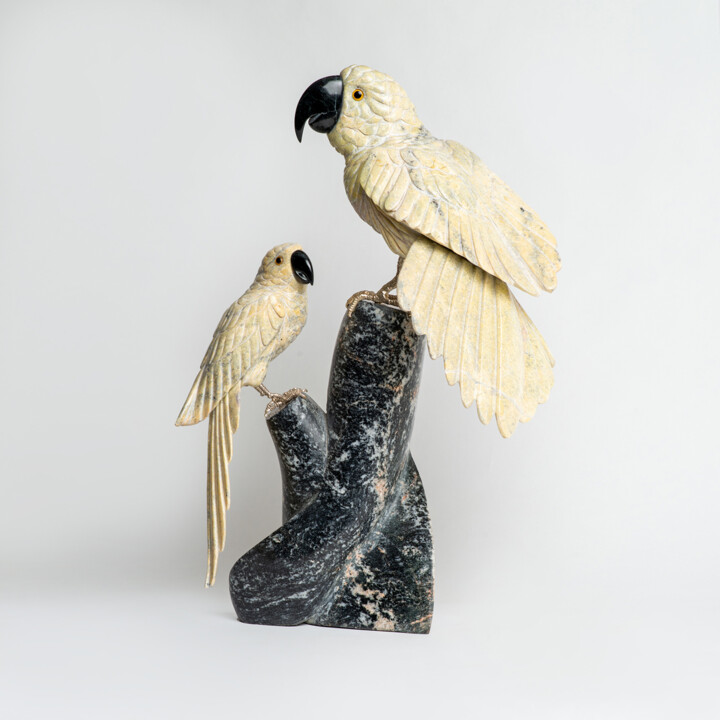
©2021 Felipe Cesar D'Oliveira Artista representado por Rocas y cristales
Evolutions of theses contemporary works in the art market
As we navigate through the 21st century, the dynamic landscape of contemporary art continues to evolve and expand, reflecting our ever-changing world. Contemporary paintings, once primarily confined to two-dimensional canvases, now embrace a multitude of forms and techniques, ranging from mixed media installations to digital creations, each piece a rich a weaving of thoughts, emotions, and narratives. Sculpture, too, has ventured far beyond traditional stone and bronze, with artists incorporating light, sound, and even motion, embodying the ephemerality and flux of the modern world.
Photography, in the hands of contemporary artists, has expanded its horizons, seamlessly blending with digital technology to create breathtaking imagery that challenges our perception of reality. Drawing, as well, has transcended the borders of paper, incorporating multimedia elements and exploratory techniques to redefine its role in the artistic discourse. Printmaking continues to flourish, with contemporary artists using traditional methods in innovative ways to deliver potent social and personal commentaries.
Textile art, once considered a craft, now holds a prominent place in the contemporary art world, with artists using it to explore issues of identity, tradition, and cultural heritage. Meanwhile, digital art, the newest member of the contemporary art family, has revolutionized the way we create and interact with art, presenting immersive experiences that blur the boundary between the virtual and the physical.
These diverse forms of contemporary art hold significant value in the current art market, not only due to their aesthetic appeal but also their ability to encapsulate and communicate complex ideas and emotions. Collectors, curators, and art lovers worldwide seek these works, drawn to their inherent dynamism, their innovative use of materials, and their eloquent expressions of our shared human experience. As a testimonial to our times, these contemporary artworks encapsulate the pulse of our society and the resonance of individual voices, forever etching our collective narrative into the annals of art history.
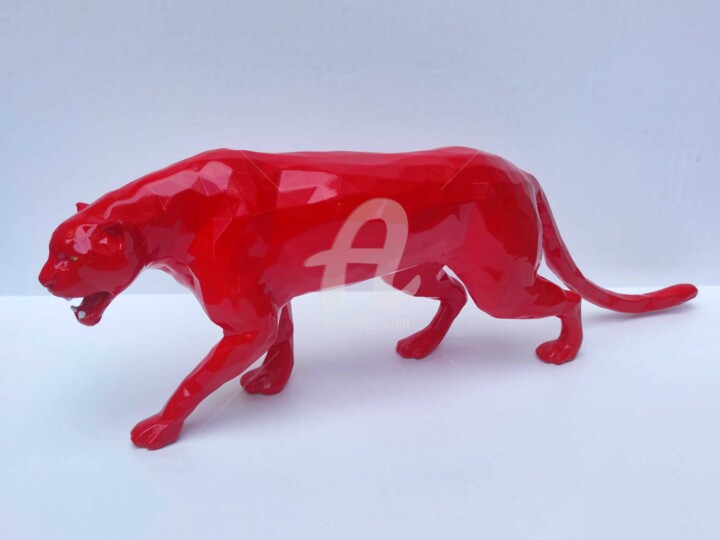
©2022 Ded2008 Artista representado por ARTEnovance
Famous Contemporary Artists
As we delve into the vibrant realm of contemporary art, we encounter an array of artists who shape this dynamic field. Each a master in their medium - painting, sculpture, photography, drawing, printmaking, textile, or digital art - they push artistic boundaries, reflecting our era and challenging perceptions. Let’s explore these remarkable contributors and their groundbreaking works.
1. Gerhard Richter - Known for his multi-faceted approach to painting, Richter challenges the boundaries of the medium, masterfully oscillating between abstract and photorealistic styles. His works, whether featuring squeegee-pulled pigments or blurred photographic images, engage in a fascinating dialogue with perception.
2. Jeff Koons - A significant figure in contemporary sculpture, Koons crafts monumental pieces that explore themes of consumerism, taste, and popular culture. His iconic balloon animals, constructed in mirror-polished stainless steel, captivate with their playful yet profound commentary.
3. Cindy Sherman - An acclaimed photographer, Sherman uses her lens to explore identity and societal roles, particularly of women. Renowned for her conceptual self-portraits, she assumes myriad characters, pushing the boundaries of photography as a medium of artistic expression.
4. David Hockney - Hockney, with his prolific output spanning six decades, is a pivotal figure in contemporary drawing. His bold use of color and playful exploration of perspective convey an intoxicating sense of joy and an unabashed celebration of life.
5. Kiki Smith - An innovative printmaker, Smith’s work explores the human condition, particularly the female body and its social and cultural connotations. Her etchings and lithographs speak to universal experiences of life, death, and transformation.
6. El Anatsui - A master of textile art, Anatsui creates stunning tapestry-like installations from discarded bottle caps and aluminum scraps. These shimmering, flexible sculptures blend traditional African aesthetic with contemporary art sensibilities, speaking to themes of consumption, waste, and the interconnectedness of our world.
7. Rafael Lozano-Hemmer - A leading figure in digital art, Lozano-Hemmer utilizes technology to create interactive installations that blend architecture and performance art. His work, often participatory in nature, explores themes of surveillance, privacy, and the relationship between people and their environments.
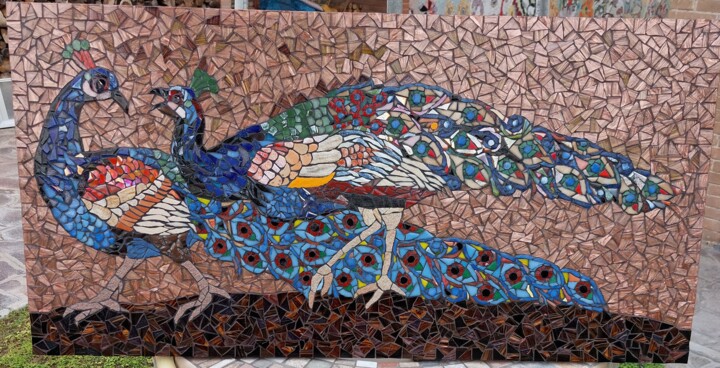
©2022 Roberto Rubiola
Notable contemporary artworks
The contemporary art landscape is a dynamic patchwork of diverse expressions and groundbreaking ideas, each artwork a unique dialog with its audience. Here are a selection of some renowned contemporary artworks, spanning various media such as painting, sculpture, photography, drawing, printmaking, textile art, and digital art, that have profoundly influenced this vibrant movement.
"Cloud Gate" by Anish Kapoor, 2006 - This monumental stainless steel sculpture, also known as "The Bean," mirrors and distorts the Chicago skyline and onlookers in its seamless, liquid-like surface, creating an interactive experience that blurs the line between the artwork and the viewer.
"Marilyn Diptych" by Andy Warhol, 1962 - An iconic piece of pop art, this silkscreen painting features fifty images of Marilyn Monroe. Half brightly colored, half in black and white, it reflects the dichotomy of celebrity life and its influence on popular culture.
"Rhein II" by Andreas Gursky, 1999 - This photographic artwork, a digitally-altered image of the Rhine River, is celebrated for its minimalist aesthetic. It strips the landscape to its bare essentials, invoking a sense of tranquility and vastness.
"Black Square" by Kazimir Malevich, 1915 - A revolutionary painting in the realm of abstract art, this piece, featuring nothing more than a black square on a white field, challenges traditional notions of representation, symbolizing a new era in artistic expression.
"Puppy" by Jeff Koons, 1992 - This giant sculpture, a West Highland Terrier blanketed in flowering plants, explores themes of innocence, consumer culture, and the interplay between high art and kitsch. It’s a delightful blend of traditional sculpture and garden craft.
"Re-projection: Hoerengracht" by Ed and Nancy Kienholz, 1983-1988 - A room-sized tableau representing Amsterdam’s red-light district, this work combines elements of sculpture, painting, lighting, and found objects. It engages viewers in a stark commentary on commodification and objectification.
"Untitled" (Your body is a battleground) by Barbara Kruger, 1989 - This photomontage, combining black-and-white photography with impactful text, explores issues of feminism, identity, and power. Its potent, confrontational message is a prime example of the power of text in contemporary visual art.
"For the Love of God" by Damien Hirst, 2007 - This sculpture, a platinum cast of a human skull encrusted with 8,601 diamonds, probes themes of mortality, value, and the human fascination with luxury and decadence. It’s a compelling blend of macabre and magnificence.
"Physical impossibility of Death in the Mind of Someone Living" by Damien Hirst, 1991 - This artwork, featuring a tiger shark preserved in formaldehyde, blurs the line between traditional sculpture and biological specimen. It prompts viewers to contemplate mortality and nature’s ferocity.
"One and Three Chairs" by Joseph Kosuth, 1965 - A piece of conceptual art, it presents a physical chair, a photograph of a chair, and a dictionary definition of a chair, thus exploring the relationship between language, picture, and referent in art.
These pieces, in their diversity, exemplify the rich tapestry of contemporary art, each piece a unique commentary on our world and a testament to the limitless potential of creative expression.

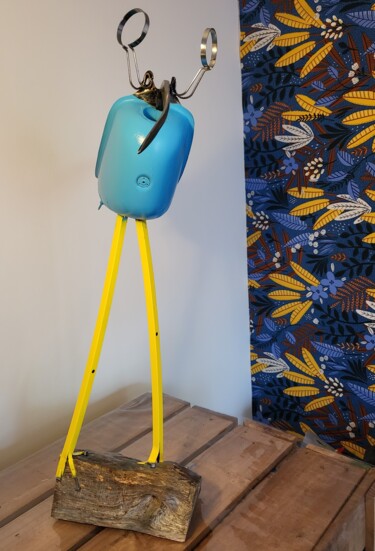
Matthieu Faucher (LUnivArtDeMatthieu - LUADM)
Escultura - Metais | 33,5x13,8 in
